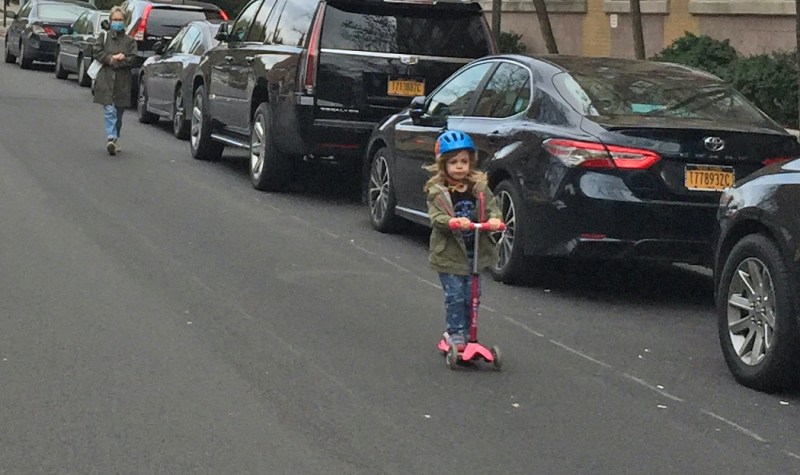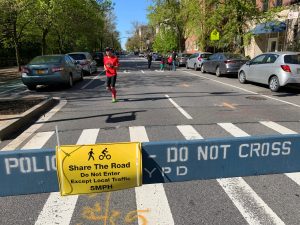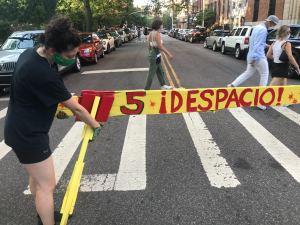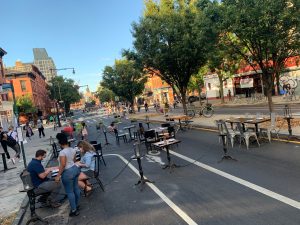UPDATE: Mayor’s First Seven Miles of ‘Open Streets’ Start Saturday!

You’re getting an open street! And you’re getting an open-street! But the rest of you … not yet.
The city will start taking 100 miles of roadway back from drivers for socially responsible recreation with about seven miles, focusing on parks beginning on Monday, the mayor said on Friday. The plan was initially set to start Monday, but in a Friday night tweet, Hizzoner said he was handing out the Christmas presents early.
BREAKING NEWS:
#OpenStreets are starting early!Thanks to quick work by the @NYC_DOT, @NYCParks and @NYPDNews, we’re going to open up the first 7 miles of streets for pedestrians and cyclists SATURDAY.
PLEASE practice social distancing and stay safe.
— Mayor Eric Adams (@NYCMayor) May 2, 2020
In his earlier announcement, De Blasio had mentioned that the new open roadways would be “enforced,” but a subsequent press release from his office did not include any mention of an NYPD role in the program. An earlier open-streets pilot program overseen by the police department was scrubbed after 11 days, as the NYPD said it required too much of their manpower.
It is unclear if that problem has been solved. The agency had testified at a City Council hearing as recently as last Friday that the NYPD could not undertake an open-space program. A spokesperson for City Hall later told Streetsblog that the NYPD will monitor the first wave of open streets, but the limitations on drivers will be enforced with barriers and signage.
For now, here’s the breakdown of the total 7.1 miles:
These roadways will be off-limits to cars inside parks:
The fact that the majority of “open streets” are inside parks was not seen as a success from many safe streets advocates.
“This can’t be stressed enough,” tweeted Doug Gordon. “Getting cars out of parks [does not equal] open streets.”
These roadways will be off-limits to cars adjacent to parks:
“The focus on streets near parks because of the warmer weather — we want to expand parks, if you will,” said the mayor, who said 40 miles of roadways would be opened up in May, towards the 100-mile goal. “That’s the beginning and we will expand from there.”
The mayor said the roadways would have “proper enforcement…with vigilant eyes,” but did not specify the exact role of the NYPD — and offered contradictory information about whether New York would continue to use the model of the NYPD’s original open space pilot, which was quickly scrubbed because it required too many cops, or whether the city would use the Oakland model of simply putting up “Closed to Thru-Traffic” signs.
“We don’t want to open up space and it becomes a gathering space or we open up space and there isn’t enforcement or cars can still access it,” the mayor said in his press conference (though not in his press release). “That was a critique I had about other parts of the country. This will be well protected and well regulated space, which is why we have to do it in phases. But a family will feel very, very comfortable.”
Despite the official nature of the announcement, a lot remains in flux — especially the role that community groups are expected to play. An email was apparently sent out to community boards that suggested an enhanced — and possibly unworkable — role for neighborhood groups:
Peter Beadle, a Queens community board member, posted some details on Twitter.
“It is going to be very hard to open streets in NYC with all the rules the city is creating,” Beadle said. ‘[The plan] requires local community organizations essentially adopt and manage any closed street. Just close the damn streets to cars! Create super blocks.”
The City Hall press release did reveal some details:
- Pedestrians and cyclists can use the roadbed of each open street.
- No through traffic will be permitted, with remaining vehicle traffic limited to local deliveries, pick-ups/drop-offs, necessary city service vehicles, and emergency vehicles only.
- These drivers are alerted to be hyper-vigilant and to drive at 5 miles per hour along these routes.
- Organizations and community boards wishing to have other New York City streets considered for the open streets program should reach out to openstreets@dot.nyc.gov or fill out the online survey here.
The release quoted many city officials and members of the City Council but, tellingly, no member of the NYPD.
The mayor’s initial list will certainly disappoint residents of Jackson Heights and Corona, who rallied for 34th Avenue — a redundant roadway that parallels Northern Boulevard — to be included. Two dozen neighbors created open space as a demonstration earlier this week, blocking cars at 90th Street, without the need for police.
Residents of the Rockaways were also disappointed by the initial list:
How can @NYCMayor completely exclude #Rockaways when people are already seeing out open space like the beach? We need STREETS closed to vehicles! We've already fought hard for parks closed to vehicles!
— Make Queens Safer (@MakeQueensSafer) May 1, 2020
And Manhattan Borough President Gale Brewer, who has called for Broadway between Times Square and Soho to be opened for pedestrians, did not get her request on the initial list. But Trottenberg hinted that it may come soon, given her emphasis that “business improvement districts and neighborhood groups” would be involved in securing the open space.
But residents near Prospect Park will likely be pleased. Parkside Avenue — on the park’s very crowded eastern edge — and even a part of Prospect Park West is expected to be opened as public space. (The four-block Prospect Park West segment may require enforcement, as that one-way southbound roadway is used by many drivers.)
The inclusion of the roadway along Carl Schurz Park in Upper Manhattan is particularly ironic, given that the mayor’s home — Gracie Mansion — is inside that park. The mayor was confronted last weekend by a Brooklynite who was angered that the mayor is regularly driven 11 miles from the mansion to Prospect Park so he can recreate. Perhaps he will now use East End Avenue.
Even if he doesn’t, the area’s council member, Ben Kallos, shared his support.
“East End Avenue is a perfect street to open exclusively to pedestrians,” said Kallos, who lobbied the mayor for the inclusion of that roadway. “Once the street is open to pedestrians, this will relieve the pressure off our local parks and give everyone the space they need to the practice social distancing outdoors correctly.”
The announcement could be seen as a small start, but it does come as the Department of Transportation has repeatedly said it is straining to fulfill its mission during the COVID-19 crisis, with a staff scattered by the virus.
“Our agency’s ability to do the requisite planning, traffic studies, and fieldwork needed for projects is significantly hampered,” spokesman Brian Zumhagen said on Thursday in a question not related to today’s announcement.
It’s also important to point out that Oakland’s much-lauded plan, announced on April 9, to create 74 miles of open streets that are off-limits to thru-traffic has resulted in about 10 miles of roads so far.
The NYPD’s initial insistence of heavily staffing New York’s four initial open streets prompted an epic takedown by Streetsblog’s in-house satire band, the Speeders:








